Environmentally Conscious Office: Daiwa House Saga BuildingAn Office Capable of Self-Supplying Electricity
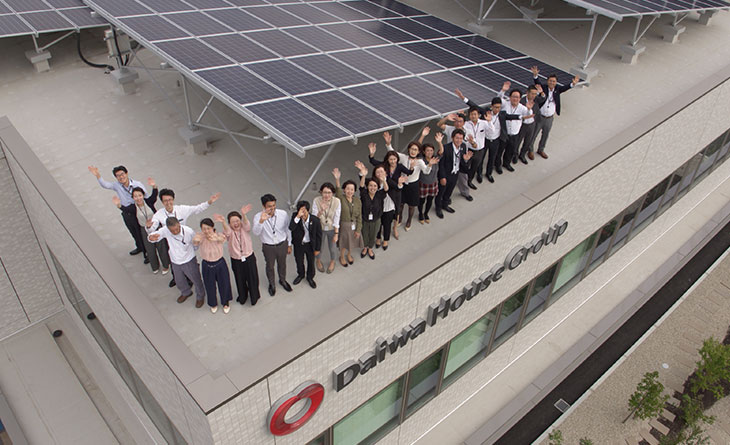
Here we will introduce the Daiwa House Saga Building, which has been conducting a demonstration experiment on self-sufficient electricity using renewable energy since February 2018.
This initiative was recognized and awarded the Minister of Land, Infrastructure, Transport and Tourism Award at the 1st EcoPro Awards (hosted by the Japan Environmental Management Association for Industry) in November 2018.

An Office Building to Embody EP100 and RE100
In March 2018, the Daiwa House Group joined the international initiatives EP100 and RE100 to enhance energy efficiency and promote the use of renewable energy.
The Daiwa House Saga Building uses thorough energy-saving measures, such as natural ventilation, a cooling system using well water and solar heat, and lighting utilizing natural light, reducing electricity usage by approximately 52%. Additionally, it has introduced a power self-sufficiency system that integrates a rooftop solar power generation system with batteries to aim for self-sufficiency used during business operations.
Through these efforts, the building realizes the goals of both the EP100 and RE100 initiatives.
![]()
EP100 is a corporate coalition that aims to double the energy efficiency of businesses through the introduction of energy-efficient technologies and practices.
![]()
RE100 is a corporate coalition that aims to source 100% of the electricity required for business operations from renewable energy.
Continued Operation Even During Power Outages Caused by Disasters, etc.
The Kumamoto Earthquake occurred during the planning of the Daiwa House Saga Building. Our Kumamoto Branch (currently the Kumamoto Office) was unable to operate adequately due to power outages. As a result, the need for an office capable of continuing operations without external power supply was felt, leading to the construction of the Daiwa House Saga Building as a demonstration building for a self-sufficient office.
Typically, when a power outage causes the loss of commercial AC power, standard power conditioners cannot function. The Saga Building adopted a unique method that connects solar power generation and batteries via a DC circuit, converting commercial power to DC and feeding it into the circuit. It is designed to operate independently even during power outages.
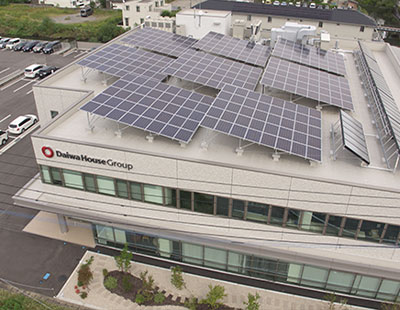
Daiwa House Saga Building
■Building outline
- Location
- 6-5 Seisho-machi, Saga City, Saga Prefecture
- Structure and scale
- Steel-framed 2-story
- Site area
- 5,556.33 ㎡
- Building area
- 1,252.60 ㎡
- Total floor area
- 2,444.57 ㎡
- Height
- Maximum 10.950 m (eaves height 8.835 m)
■Utilization of subsidies
FY 2017 Net Zero Energy Building (ZEB) Demonstration Project (the Ministry of Economy, Trade and Industry)
Overview of the Facilities
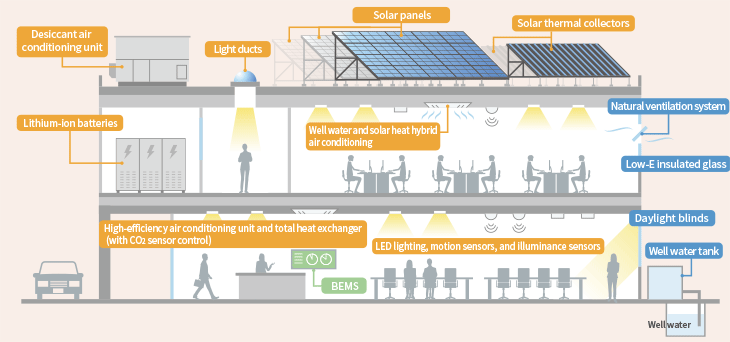
Saga Building schematic
Power self-sufficiency system
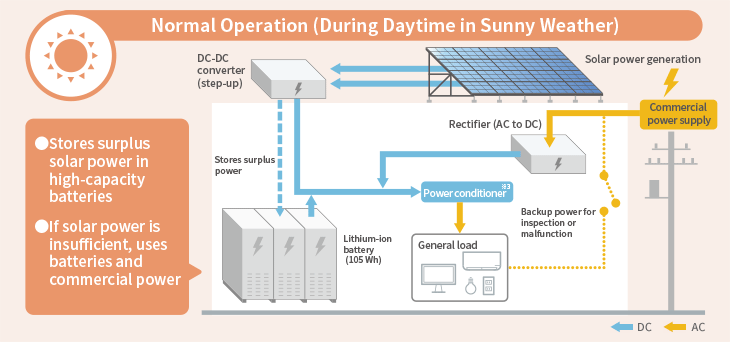

These systems enable self-sufficiency in power supply.
Inside the Office with Self-Sufficient Power
This building reduces electricity consumption by approximately 52% compared to buildings meeting the 2016 energy efficiency standards. However, employees working inside have not reported any issues with indoor brightness or temperature compared to previous buildings, and they do not feel they are compromising for energy savings. On the day of the interview, which was cloudy, the hallways and offices were bright with natural light, and the breeze through the natural ventilation windows above provided a comfortable room temperature.
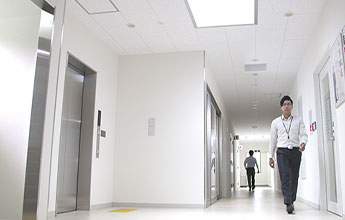
Light ducts in the ceiling bring in the natural light. Auxiliary lighting in two locations, the front and back, automatically turn off based on presence and how bright the room is.

A meeting space inside the offices. After measuring indoor and outdoor temperature and humidity, if the outside is more comfortable, a notification is sent to a person in charge of managing the windows to open the upper ventilation windows and allow airflow.
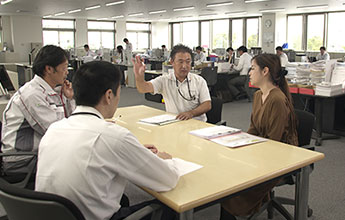
Natural light from windows is directed deep into the room using daylight blinds and highly reflective ceiling and wall materials.
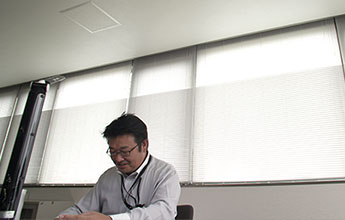
Daylight blinds block external view into the offices while softly diffusing light inside.
Details of the Demonstration Experiment
The theoretical reduction effects were calculated using equipment and design techniques, and the actual effectiveness is being verified. By analyzing the actual data obtained, it becomes possible to create a more realistic equipment layout. This verification revealed that the 83.2 kW of solar power installed on top of the Saga Building has an actual generation capacity close to 100 kW, thanks to its unique power conversion system, which significantly reduces power loss. Therefore, a design change was made midway through the experiment to increase the battery capacity from 75 kWh to 105 kWh to accommodate surplus power.
Using BEMS Data and Other Metrics to Confirm Achievement of ZEB
⇒If there is a significant discrepancy between design values and actual measurements, the causes are analyzed, which leads to forming countermeasures.
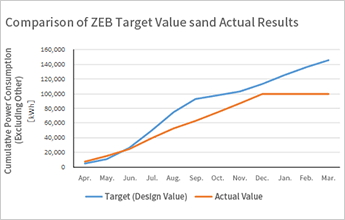
ZEB Achievement: Comparison of Targets and Results (Conceptual Diagram)

Model the Optimal Capacity of Solar Power Generation and Batteries in the Power Self-Sufficiency System
⇒Identify operational challenges and develop countermeasures
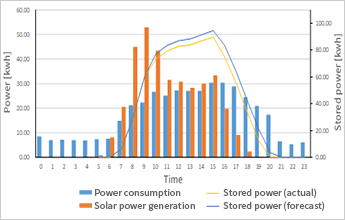
Analysis of Power Generation, Storage, Discharge, and End Time (Conceptual Diagram)
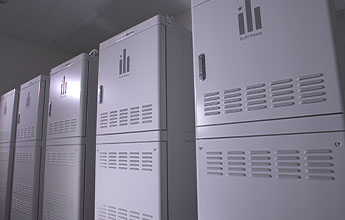
Verification of Energy-Saving Effects of Well Water/Solar Heat Hybrid Air Conditioning System
⇒Evaluate energy-saving effects during cooling, heating, intermediate periods, and normal ventilation.
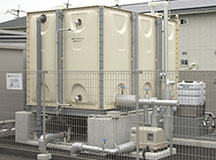
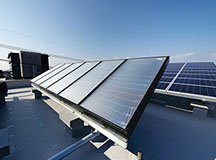

Verification of the Effectiveness of the Natural Ventilation
⇒Verification of ventilation frequency
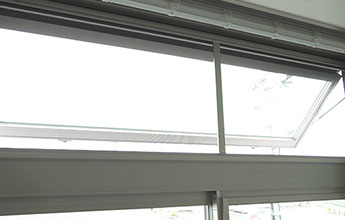
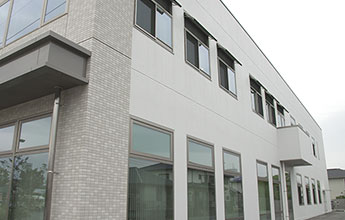
Future Developments
Saga City is known for its intense heat, with summer temperatures consistently ranking among the highest in Japan, while in winter, it is exposed to cold winds from the Sea of Japan. The knowledge gained from demonstration experiments in Saga's climate, with its large temperature fluctuations, can be applied to various environments.
In the Saga Building, abundant well water was used as an air conditioning energy source. However, depending on the region, other sources such as rivers, lakes, hot springs, geothermal energy, factory waste heat, or sewage heat can be utilized. Remaining challenges include miniaturization and cost reduction of equipment. However, these challenges will be resolved as the technology becomes more widespread. Such offices with self-sufficient power are being considered for domestic deployment and for expansion in developing countries where power infrastructure is underdeveloped.
Kyoji Morikawa, Branch Manager, Saga Branch
Offices with self-sufficient power can achieve RE100 towards decarbonization and provide business continuity planning (BCP) measures for securing energy in emergencies. At the same time, it is a future building model that can be deployed in regions where power infrastructure is underdeveloped, contributing to the local community.
Some challenges are only discovered through demonstration experiments, but we will address them one by one and horizontally deploy the results to our facilities.
Additionally, we will utilize it as a showroom to accelerate the proposal and dissemination of environmentally conscious facilities to customers, contributing to society through our work.
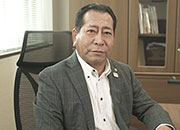
Daisuke Tashiro, Accounting Section Manager, Saga Branch
Since the plan was to significantly reduce power consumption compared to previous office buildings, I was concerned about the need for considerable energy-saving efforts from employees, but I was surprised to find that power reductions were achieved without compromising comfort.
By installing monitors displaying the status of power self-sufficiency in visible locations within the office, an atmosphere naturally emerged where all employees voluntarily engage in energy-saving efforts, like turning off unnecessary lights when the building is close to achieving 100% self-sufficiency, enhancing environmental awareness.

Voices of the Development Team
What sets the Saga Building apart from other environmentally conscious buildings is its resilience against disasters. The building achieves self-sufficiency from commercial power and minimizes solar power installation capacity to achieve Zero Energy Building (ZEB) status, seeking renewable energy for air conditioning sources, significantly reducing peak power demand.
Since the opening of the Saga Building, there has been an increase in lectures and interviews, making us feel the significant impact. In the future, we aim to accumulate the knowledge gained from this demonstration experiment and promote the dissemination of offices with self-sufficient power.

Kazunori Taniguchi
Head Office, Chief, Planning and Development Department



